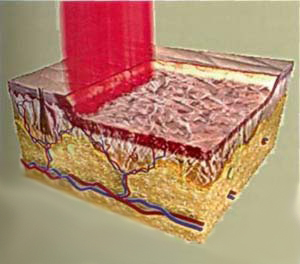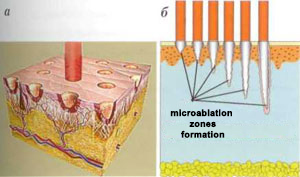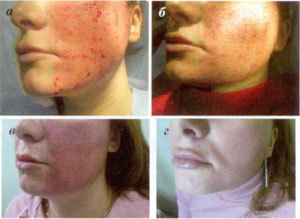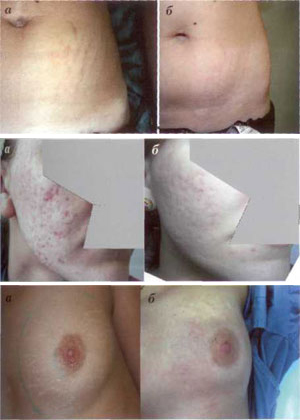Today, in the arsenal of modern dermatocosmetology there is a wide range of methods to correct various aesthetic skin imperfections - chemical peels, mechanical dermabrasion, laser rejuvenation, microdermabrasion, contouring, etc. Nevertheless, new trends and technologies in the beauty industry are constantly evolving and improving.
This trend is particularly prevalent in instrumental methods, mainly laser medicine. The use of lasers, first in dermatology and then in cosmetology, has an impressive period. Even one of the newest laser treatments - selective photothermolysis - has been around for over 25 years. The pioneers of this field, the Americans RR Anderson and JA Parrish, predetermined the fate of fractional lasers in medicine, which made them indispensable in such aesthetic treatments. Skin defects such as capillary hemangiomas. Port wine stains, hypertrichosis, tattoos, rosacea, pigmentation disorders, photography, wrinkles and so on. Sh.
Modern skin rejuvenation techniques
We live in a time when more people are living to old age than ever before. And given that many of them continue to lead active lives, one of the most important problems in aesthetic medicine is the fight against skin aging.
Plastic surgery can rejuvenate the shape of the face by removing excess skin. However, at the same time, the skin still changes over time (age-related) or external factors (photography). It is also important that most patients want to look younger, without surgery.
What method should be used in this case to affect the skin and what should be done for its true rejuvenation?
All methods that can be used to improve the appearance of the skin can be combined with one principle - they use a traumatic effect on the skin, provoking fibrosis, which further causes its tension and compression.
Currently, dermatocosmetology uses three major types of skin remodeling effects, including:
- Chemical stimulation - chemical peels with acids (trichloroacetic, glycolic, etc. );
- Mechanical stimulation - mechanical dermabrasion, microdermabrasion, mesotherapy, fillers, needle piercing;
- Thermal stimulation - laser ablation, thermolifting using lasers and broadband light sources, radiofrequency crane, fractional methods.
Chemical stimulation
Historically, acid exfoliation (peeling) was the first method of skin rejuvenation. The principle of peeling is partial (as with superficial peeling) or almost complete (as with middle and deep skin) destruction of the epidermis, damage to fibroblasts and dermis structures. This lesion activates the inflammatory response (the stronger it is, the greater the amount of destruction), which leads to additional production of collagen in the skin.
However, to achieve the desired result, peeling must be sacrificed to the epidermis. Experiments with burns have misled many, presumably "proving" that the epidermis is a renewed organ that quickly recovers from the damaged area. In this regard, peeling became more and more aggressive towards the epidermis over a period of time (e. g. , deep phenolic peeling) until the finally accumulated problems forced specialists to realize this vicious method, which eventually leads to thickening of the skin.
Proponents of deep peels have ignored the problems. Their essence was that due to the destruction of dermal papillosis and the weakening of nutrition, the epidermis becomes thinner, and the number of cells in the thin layer is significantly reduced compared to before peeling. Decreased barrier function of the stratum corneum leads to impaired skin hydration. (Therefore, after a long deep treatment, almost all patients experience severe dryness of the skin) At the same time, the introduction of light skin in practice (the use of trichloroacetic and fruit acids) did not live up to hopes for effective skin tightening.
Mechanical stimulation
Among the methods of mechanical stimulation of inventive changes in the skin, dermabrasion using rotating devices (v. speed; rotation of the cutters at 100000 min / min) deserves special attention. Currently, modern Schumann-Schreus devices are used (Germany)
Themethod can only be used in a surgical hospital as this procedure requires anesthesia, postoperative surgery of the wound surface, special toilet for the eyes and mouth, as well as equipment for feeding patients (due to pronounced postoperative swelling observed 2-3 days after the procedure. Complicates the opening of the eyes and mouth).
Themethod is very effective, but unfortunately with mechanical dermabrasion there is a high risk of complications such as:
- Persistent postoperative hyperemia;
- Appearance of the depigmentation area due to destruction of melanocytes when the incisor enters the basement membrane;
- Infection of the wound surface;
- Scars (if the incision is too deep in the skin)
All lists define the limited use of this method in clinical practice.
Thermal stimulation
Ablation Remodeling
Since the late 1980s, lasers have been used to rejuvenate the skin by removing layer-by-layer tissue (ablation) [4]. Careful, superficial removal of the skin layer using a carbon dioxide laser stimulates the synthesis of its own collagen in it, the amount of which increases several times after the procedure. Then gradually reorganizes.
It was most effective to use a CO2 laser when it was exposed to a deep thermal effect on all layers of the dermis, externally manifested by a skin tightening effect. The method is called "laser dermabrasion", or "laser rejuvenation" and in terms of effectiveness it does not oppose any method of skin rejuvenation that existed at the time (Fig. 1).

fig. 1. Traditional laser skin rejuvenation scheme (laser dermabrasion)
However, the CO2 laser action also causes a lot of complications. In addition, further studies have shown that such a profound effect on dermatitis stimulates the production of fibrous tissue more than it promotes new, normally synthesized collagen [5]. Developed fibrosis can make the skin look unnaturally pale. After treatment, collagen is synthesized after a few years, like any collagen produced at the site of scarring. With straining of the epidermis caused by atrophy of the papillary layer of the dermis, wrinkles begin to form on the skin. Due to the weakening of the barrier function of the stratum corneum, the skin hydration level decreases and looks atrophic.
Erbium - Aluminum - Yttrium garnish - Erbium lasers appeared later. Advantages of erbium lasers such as surface thermal penetration depth (embryo lasers at a depth of 30 μm, CO2 lasers - 150 μm) and (as a result) lower risk of burns and tissue carbonization, as well as relatively cheap (compared to many carbon dioxide lasers)Around the world.
Nevertheless, because of the experience gained in working with these two types of installations, it has been suggested by experts that CO2 lasers are more efficient [6]. Despite the negative effects of carbon dioxide laser dermabrasion, as described above, this method remains indispensable for correcting bump scars. In addition, it can be considered as an alternative to skin tightening - with all methods of its remodeling, only exposure to a CO2 laser can actually cause a pronounced collagen contraction with a visible clinical lifting action.
The problem with all the methods described above is that they often "sacrifice", i. e. significantly damage, the epidermis. In order to rejuvenate your skin and really look youthful, you need a perfect epidermis with natural perspiration dermatitis, good hydration, normal skin tone and elasticity. The epidermis is a very complex very specialized organ, up to 200 microns thick, which is our only protection from the influence of adverse environmental factors. Therefore, no matter what we do to rejuvenate the skin, we must make sure that its normal architecture is never damaged.
This concept has led to the emergence of oversized skin remodeling technology.
non-selective remodeling
The most common non-abrasive skin repair devices are neodymium (Nd-YAG) and diode lasers, as well as broadband light sources (IPL). The principle of their action - selective photothermolysis - consists of heating and destruction of structures, contains a sufficient amount of melanin or oxyhemoglobin. In the skin, it is, respectively, the accumulation of melanocytes (lentigo, melasma) and microdoses (telangiectasia). The wavelengths of the radiation used in non-ablation lasers correspond to the maximum absorption spectrum of oxyhemoglobin or melanin. The procedure with non-anabolic lasers and IPL treatment is quite safe, the rehabilitation period is minimal, however, such treatment excludes only pigment and vascular cosmetic defects. In this case, there is some thickening of the skin, but the effect obtained is short-lived.
Fragmented skin restoration technique
The constant search for new highly effective and at the same time safe methods of skin rejuvenation has led to the fractional delivery of revolutionary technology - laser radiation. The proposed method of skin rejuvenation has been specially designed to overcome some of the difficulties listed above. Unlike "conventional" ablation and non-ablation laser methods designed to achieve uniform thermal damage to the skin at a specific depth, fractional methods allow to achieve selective microscopic thermal damage in the form of multiple altered columns and leave unfavorable areas around these micro. Currently, the industry produces two types of fractional lasers: non-ablation and ablation.
The first uses Erbum doped fiber optics that emit radiation at a wavelength of 1550 nm. The fractional laser detects thousands and tens of thousands of micro-disorders in the skin in the form of columns - microtherapy treatment zones (MLZ) - with a diameter of 70-150. mk Depth 1359 mcm
As a result, approximately 15-35 skins occur on the photocoagulated area. Chromophore is water for the laser. Coagulation mainly occurs in the lower layers of the epidermis and dermis. The statum corneum remains intact because it contains a relatively small amount of water and this significantly reduces the risk of infection. Epidermal healing is rapid due to the low volume of lesions and the small migration distance of keratinocytes. The healing period is accompanied by moderate swelling and hyperemia, followed by desquamation, which appears on day 5-7. The patient practically does not lose social activity.
This technology - fractional photothermolysis (FF) - is a highly effective method of remodeling inefficient fractional skin. Course treatment is prescribed to achieve the desired effect. Depending on the clinical situation, it is recommended to perform 3 to 6 procedures at 4-6 week intervals. As with any other method of uncontrolled skin, the final result can be seen only 4-8 months after the procedure (cumulative effect).

In cases where more aggressive action is needed on the skin - correction of scars, deep wrinkles and excess skin, the method of fractional ablation (FA, or fragmentary deep dermal ablation - FDDA) is used.
Thefractional ablation method combines the advantages of a CO2 laser with the principle of laser radiation delivery. Unlike CO2 lasers, which layer the entire surface of the skin, FA units form huge numbers of zones (MAL) up to 300 mm in diameter, with an evaporation depth of 350 to 1800 μm (Fig. 2).
Thus, during this procedure, the laser radiation penetrates deep into the skin, destroying the top layer of the epidermis. In terms of effectiveness, ablative fractional laser rejuvenation can be compared to plastic surgery, this is how deepening the laser beam is.
fig. 2. The principle of operation of ablation fractional laser: formation of microabolic zones - MAZ (a); Dependence of MAZ formation depth on laser radiation energy (b)
As with FF, 15 to 35% of the treated area skin is actually exposed (up to 70% in some cases). Recovery after the FA procedure is faster than after layer-by-layer ablation. This is because part of the important epidermis and stratum corneum remains intact. After the procedure, bleeding of the skin is observed for some time, but soon it stops (Figure 3a, b).
fig. 3. Step-by-step skin rejuvenation after fractional ablation procedure: Consider treatment immediately (a); Every other day (b); After 5 days (c); 14 days (d) after one procedure

Numerous microbes emerge in the dermatitis, causing a complex cascade of changes that lead to the production of new collagen. After the bleeding has stopped, it is necessary to remove the serous fluid left on the skin surface. Its release is observed within 48 hours after the end of the procedure, until complete epithelialization of the microelectric zones. During this period, the patient uses special wound healing external agents. The skin usually starts within 3-4 days and the swelling increases (Figure 3g). By day 7, these phenomena gradually subside and erythema remains only a noticeable side effect (Figure 3). The duration of erythema depends on the parameters of the laser exposure and the vascular properties of the skin. According to the author, erythema lasts no more than 3 months.
Loss of social activity by the patient 5 to 10 days after completion of the FA procedure.
Careful skin care is essential to prevent scarring and to detect further inflammatory pigmentation. Decorative cosmetics can be used for 4-5 days. A prerequisite for a good result is the use for at least 3 months after treatment with sunscreen with a high level of protection (SPF at least 50). The risk of post-inflammatory pigmentation is noted in 20% of patients and is generally higher in skin patients with IV-V phototypes. Such hyperpigmentation is transient and can last from 1 week to 3 months, depending on the depth of treatment and the area of the treated area. For its prophylaxis 1-2 weeks before the procedure and during and after 2 weeks, hydroquinone-based external agents (4%) and tertinoin (0. 1%) are prescribed. The main actions on the facial skin after the FA procedure are as follows: pronounced tightening and reduction of excess skin, smoothing the surface. Wrinkled skin, as well as skin affected by skin rashes, decreased dyschromia, porosity.
This method was tested by the author and his colleagues also to remove marks on the skin section. As can be seen from clinical studies, this method has shown high efficacy in eliminating almost all types of stretch marks, both acquired during adolescence and childbirth. It has been noted that healing processes on the skin of the body are different from those on the skin of the body.
Skin repair mechanism when using a fractional laser
Consider the mechanisms of skin reduction when using a fractional laser.
After exposure to a laser, aseptic inflammation develops in the area of micro-wounds. The more aggressive the laser exposure, the more pronounced the inflammatory response, which, in fact, stimulates further traumatic release of tissue growth factors damaged by fibroblasts and damaged tissues. The impending reaction is automatically accompanied by an increase in cellular activity, which inevitably leads to the fact that fibroblasts begin to produce more collagen and elastin. The skin repair process involves three classic phases of regeneration:
- Stage I - change (inflammation of the tissue). Begins immediately after injury;
- Phase II - Proliferation (tissue formation). Begins 3-5 days after injury and lasts for about 8 weeks;
- Phase III - Tissue Remodeling. Lasts from 8 weeks to 12 months.
It should be noted that all three phases of skin regeneration are observed after both fractional photothermolysis and fractional ablation. But in the first case, the harmful effects of the laser are moderately aggressive, resulting in a cascading ignition is never wild.
A completely different picture is observed after exposure to fractional ablation laser. The trauma caused by this laser disrupts the blood vessels while the blood cells, in the serum, are released into the surrounding tissue. The mechanism of full-fledged skin regeneration - begins with pha change - develops aseptic inflammation. Platelets released from damaged vessels play an important role in activating blood clotting and releasing chemotoxic factors, in turn attracting other platelets, leukocytes, and fibroblasts. Leukocytes, in particular neutrophils, participate in the cleansing of destroyed tissue, the removal of fragments of necrotic tissue that are partially destroyed by phagocytes, and partially emerge on the surface of the skin in the form of microscopic debris consisting of epidermal and gastric tissue.
The proliferative phase begins in about 5 days. During this period, neutrophils are replaced by monocytes. Monocytes, keratinocytes and fibroblasts continue to be affected by growth factors and at the same time are exposed to their opposite effects. Keratinocytes stimulate the growth of the epidermis and release growth factors that are needed by fibroblasts to stimulate collagen production. At this point, new blood vessels are formed, intensively forming a cellular matrix.
The last, reconstructive, healing phase lasts several months after fractional laser exposure.
On the 5th day after injury, the fibronectin matrix "fits" along the axis along which the fibroblasts are bent and along which collagen is built. An important role in the formation of this matrix is played by growth factor β (TGF-β is a potent fibroblast) (as well as other growth factors). The primary form of collagen in the early stages of wound healing is type III collagen (this type of collagen is located in the upper layer of the dermis, below the basal layer of the epidermis). The longer the replacement phase, the more type III collagen is produced, but in any case, its amount increases by a maximum of 5 to 7 days after injury. Collagen type III is gradually replaced by collagen for about a year in type I, which enhances skin firmness. Blood circulation gradually normalizes, the skin becomes smoother and acquires a natural color.
Comparative analysis of laser skin rejuvenation methods
In the above summary, we present to your attention a diagram showing the effectiveness and safety of laser skin remodeling methods.
Advantages of fractional track rejuvenation methods. The advantages of fractional methods used in clinical practice include:
- Controlled minimal skin damage. Histological examination after the procedure shows an increase in the amount of peripherals in the dermis, which characterizes the skin changes as productive regeneration;
- Its effective rejuvenation: the skin becomes thicker, it significantly (more than 400% (! )) increases the production of collagen and elastin;
- Short treatment time: average 3 days after FF and 7-14 days after PA;
- Minimal risk of hyperpigmentation;
- Ability to perform the procedure in patients with thin skin;
- Ability to have a healing effect on any part of the body;
- Ability to use light weight anesthesia: only local application anesthesia is used for fractional photomotels; Disappearance of telangiectasias (due to the disruption of blood vessels in so many places, it is impossible to restore them).
Basic indications for fractional treatment

Indications for fractional photothermolysis:
- Increase skin density in the early stages of aging. The FF procedure is relatively simple and can be performed without fear. Therapeutic effect can be used on the neck, décolleté, arms, abdomen, thighs, breasts;
- skin photography;
- Hyperpigmentation, melasma;
- hypertrophic scars;
- Stretch marks.
Signs of fractional ablation:
- Wrinkles of varying severity - from thin lines, strongly expressed (in the form of fur);
- age-related skin elasticity and firmness;
- Excess skin on eyelids, neck, face (as an alternative to plastic surgery);
- Uneven skin texture;
- Expressed skin photography;
- acne scars;
- Cicatricial deformation of the skin after injuries, surgeries;
- Hyperpigmentation: melasma, lentiginosis, alcoholic pigmentation, etc. Sh. Vascular dyschromia;
- signs of skin stretching;
- Actinic keratosis.
- First of all, laser skin repair is recognized as the most effective today; Secondly, the scope of coverage of aesthetic and dermatological problems solved by these methods is very large - from skin rejuvenation to the treatment of congenital and acquired skin pathologies; Third, third, with the advent of fractional technologies, the safety and efficacy of treatment have become predictable.














































































